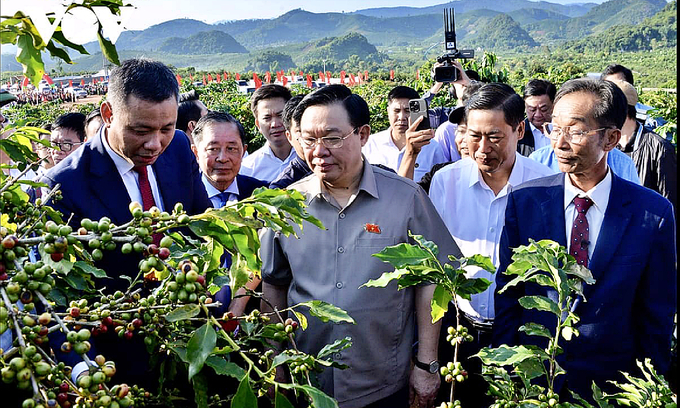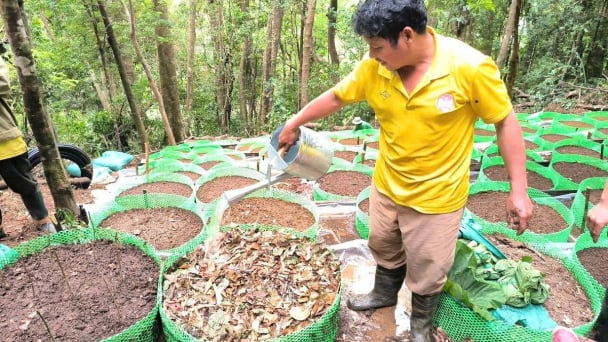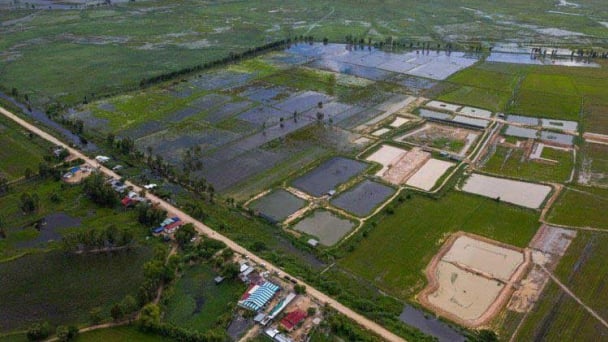May 17, 2025 | 10:10 GMT +7
May 17, 2025 | 10:10 GMT +7
Hotline: 0913.378.918
May 17, 2025 | 10:10 GMT +7
Hotline: 0913.378.918

Chairman of the National Assembly Vuong Dinh Hue visited the coffee garden of Bich Thao Cooperative.
Laughing endlessly about the 2023 - 2024 coffee crop with reasonable prices, Mrs. Cam Thi Mon in Chieng Chung commune, Mai Son district, Son La province, said that her family and people in the area have converted from growing corn from ineffective cassava to growing coffee for decades.
Up to now, households have mastered farming, maintaining an average productivity of 10 - 12 tons/ha per year. At the beginning of this season, traders came to ask to buy coffee for VND 10,000 - 11,000 per kilogram from the garden. She was pleased because the price was VND 2,000 - 3,000 per kilogram higher than the previous season. Unexpectedly, coffee prices continued to increase until the end of the harvest.
Around late January 2024, coffee prices peaked at VND 15,000 per kilogram fresh, nearly doubling compared to the previous year. Thanks to that, the economy of her family and many surrounding coffee farming households is increasingly better.
Coffee is identified as one of Son La's essential agricultural products. According to statistics from the Provincial Department of Agriculture and Rural Development, the locality currently has about 20,000 hectares of coffee, concentrated in Mai Son district (more than 8,500 hectares) and Thuan Chau (nearly 6,000 hectares), with the rest scattered in Son La and Yen Chau cities and Sop Cop. Son La's green coffee output is estimated at 35,000 tons.

Mrs. Cam Thi Mon in Chieng Chung commune, Mai Son district, in the coffee garden.
Compared to the Central Highlands, coffee in Son La is arabica (tea coffee), has a slightly sour taste, does not suit the tastes of domestic consumers, but has high export value to European countries.
Son La has successfully built the pure powder coffee brand of Bich Thao Cooperative, the province's only 5-star OCOP product, widely welcomed by domestic and international consumers.
There is a lot of potential, but in recent years, coffee farming activities in Son La have significantly been affected by unusual weather phenomena such as rising temperatures and irregular rainfall, causing farming productivity and income to fall. Farmers' income faces many unfavorable developments.
Son La is still one of the provinces with the highest poverty rate in the country, at 23.9% (according to the General Statistics Office in 2022). In addition, 85% of Son La's population are ethnic minorities, with the economy largely dependent on agricultural production and heavily affected by climate change.
Determining this, through the Origin Grants program of the Starbucks Foundation, CARE Vietnam coordinated with the Sub-Department of Crop Production and Plant Protection of Son La province to implement the SURE (Sustainable and Resilient Livelihoods for Women Coffee Producers in Son La).
Implemented over 36 months in 4 communes in Thuan Chau and Mai Son districts, the SURE will design interventions to increase women's decision-making ability, aiming to increase benefits for themselves, their families, and the community their copper.
This approach empowers women to manage resources, assets, and economic opportunities equitably and create lasting changes in social norms and financial structures.
"We want to support women in coffee, tea, and cocoa-growing communities to create opportunities and help them improve their lives. We understand that investing in a woman will create a ripple effect and positive results for her family and the surrounding community."

Leaders of Son La province and CARE Vietnam signed a memorandum of cooperation.
During three years of implementation, the SURE aims to reach and enhance women's economic empowerment for 1,500 female farmers from ethnic minority communities in Thuan Chau and Mai Son districts in Son La province.
Mr. Le Xuan Hieu, Rural Program Manager of CARE Vietnam, said the project's approach will focus on three aspects: Diversifying income sources, improving farming scale and market access, and adapting to climate change.
"In the long term, the SURE aims to increase local resources, helping local communities, especially women, to carry out effective and autonomous livelihood activities in their living environment.", Mr. Hieu expressed.
In ethnic minority areas, mountainous areas, and remote areas, women play a significant role in the family economy. However, in addition to this burden, they have to bear many other impacts, such as caring for the family, collecting firewood, etc.
Mrs. Cam Thi Phong, Deputy Director of the Department of Agriculture and Rural Development of Son La province, considers the solutions of the SURE as part of the solution to the problem of diversifying livelihood activities and improving the self-reliance of the local coffee farming community.
"We are keenly aware of the impact of climate change on agricultural production. Son La has introduced many appropriate and practical solutions to farmers. We welcome the SURE to help people have more choices and develop more sustainably in the current context," she emphasized.
Translated by Tuan Huy
/2025/05/16/3800-0-nongnghiep-143756.jpg)
(VAN) Suntory PepsiCo Vietnam coordinated with the Ministry of Education and Training to implement an education program on water conservation, reaching nearly 1 million primary school students nationwide.

(VAN) Vietnam’s TH Group officially put its high-tech fresh milk processing plant into operation in the Russian Federation, marking a historic moment as the first TH true MILK cartons were produced in Russia.

(VAN) Use of high-quality broodstock and biotechnology is regarded as the most effective approach to ensuring sustainable and economically viable shrimp aquaculture ahead of climate change and the emergence of increasingly intricate disease patterns.

(VAN) Carbon farming is a form of agricultural practices that helps absorb more greenhouse gases than it emits, through smart management of soil, crops, and livestock.

(VAN) This is a key content of the Memorandum of Understanding recently signed between the Vietnam Fisheries Society and Kunihiro Inc of Japan.

(VAN) To achieve the goal, local authorities and businesses in Kon Tum province have fully prepared the necessary conditions for the new Ngoc Linh ginseng planting season.

(VAN) Jiangsu province is gearing up to host training programs in Phnom Penh, the capital of Cambodia, this year to establish the Fish and Rice Corridor.